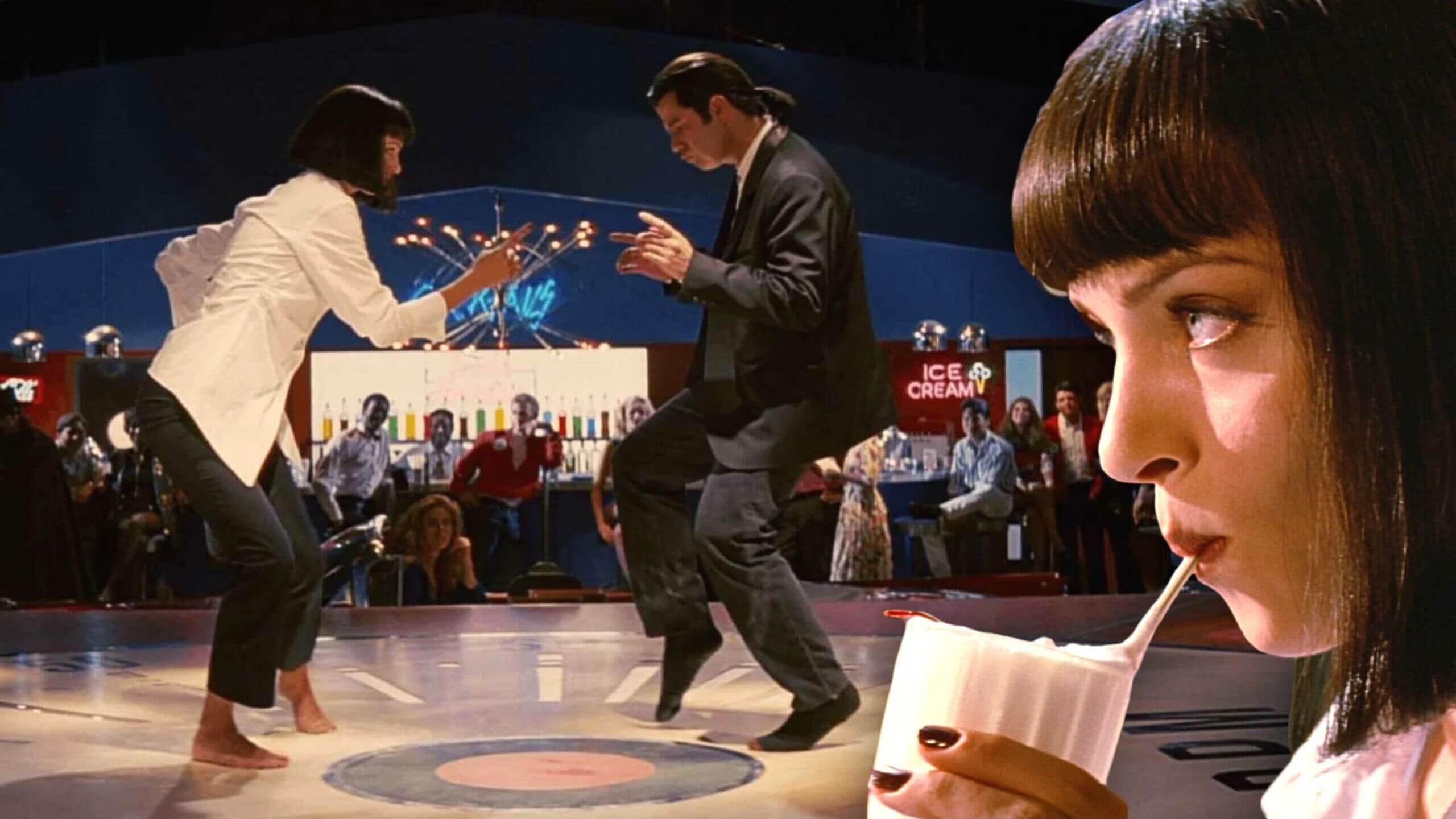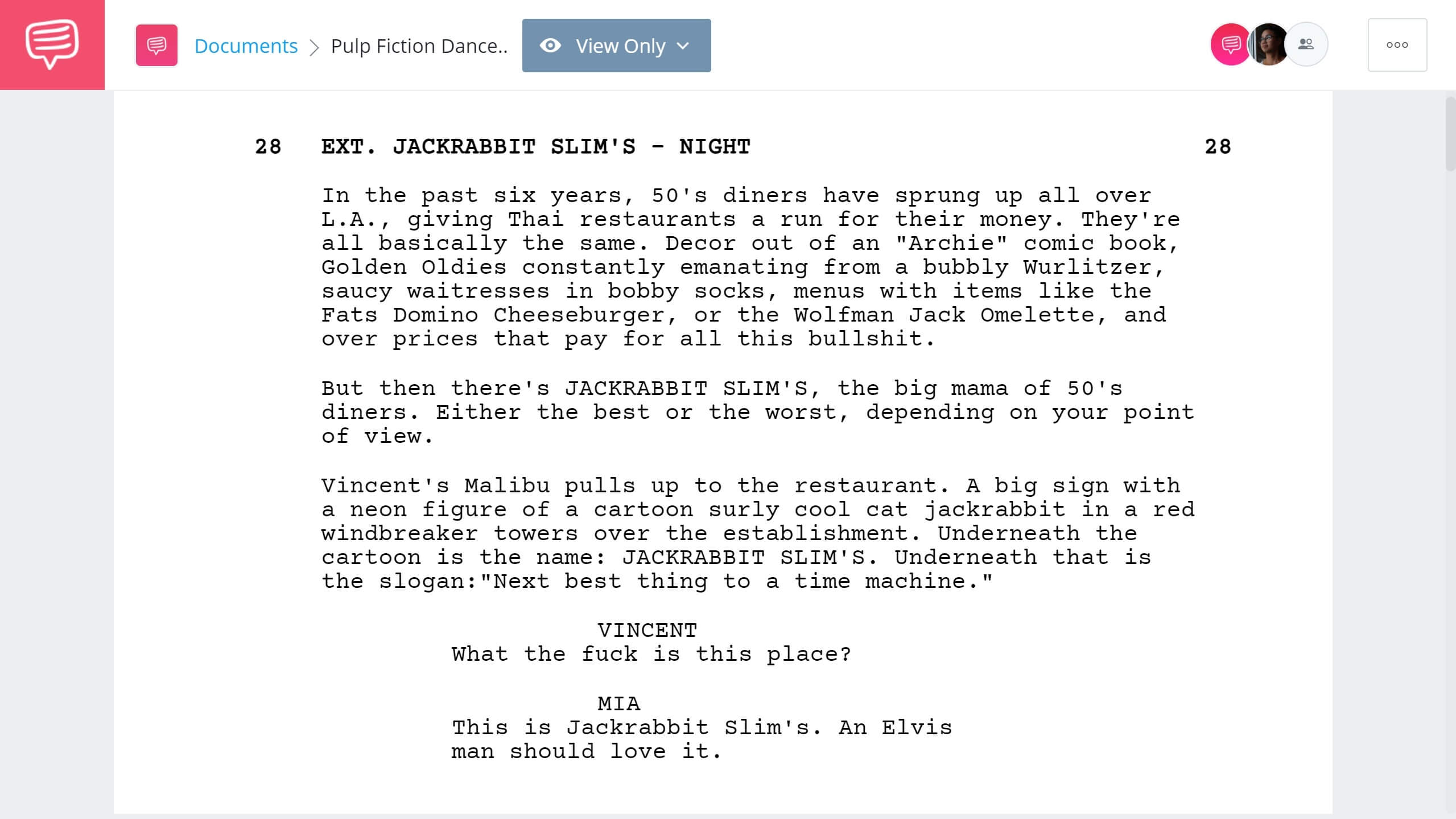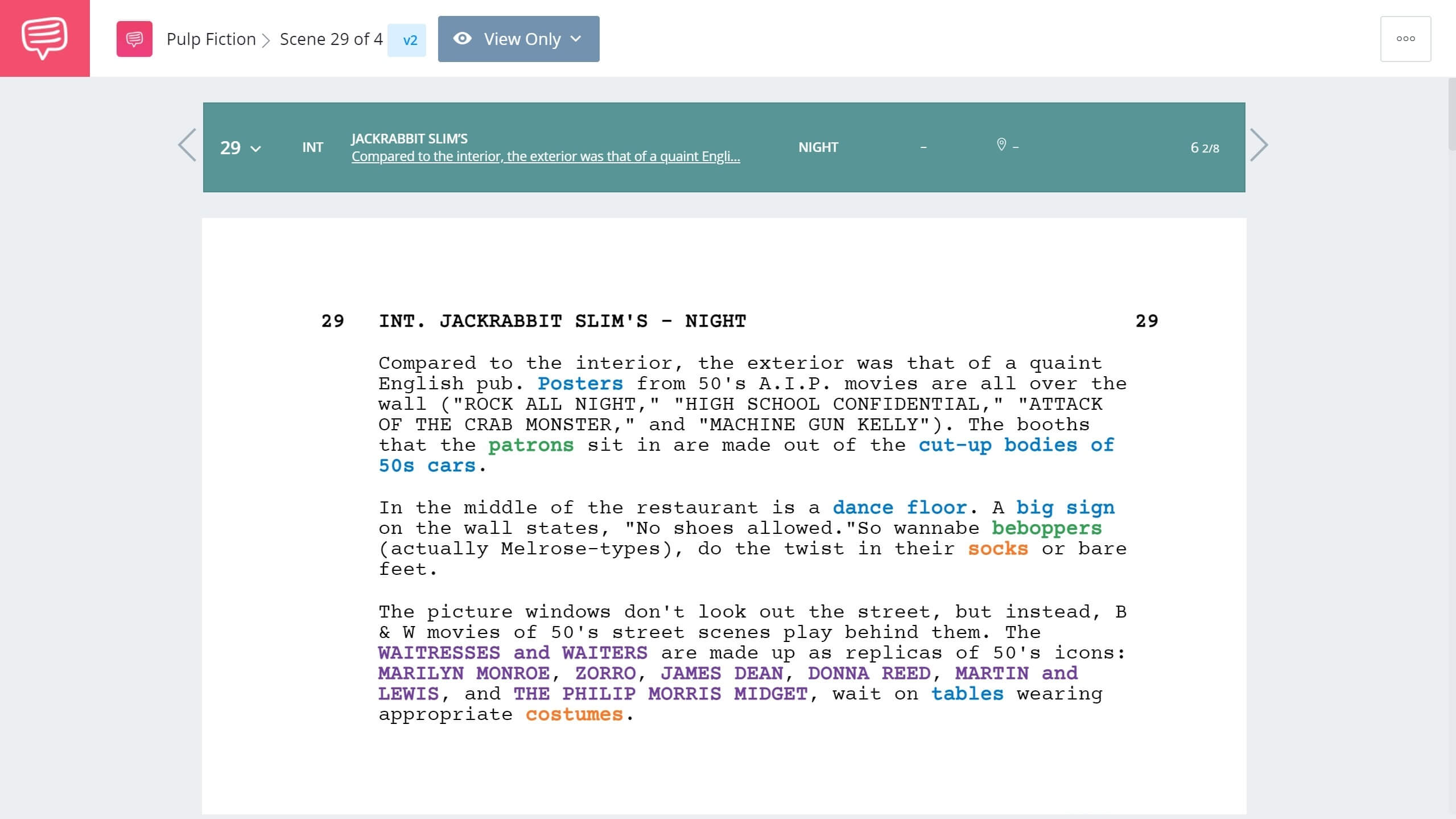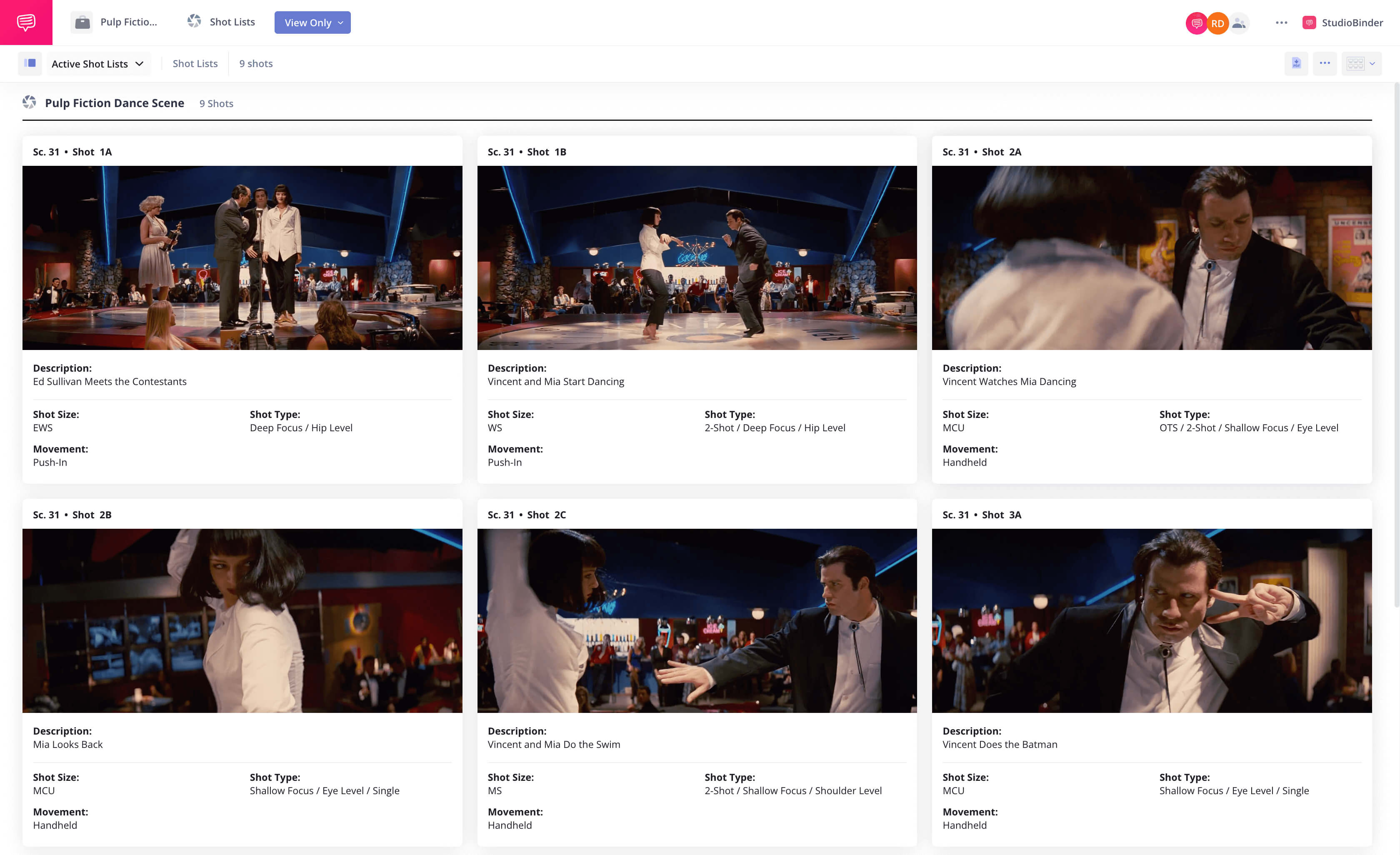How does a director create a memorable scene? The Pulp Fiction scene dance made a lasting impact in pop culture consciousness, still inspiring Halloween costumes, hairstyles, and dance moves nearly two decades later. But what techniques did Quentin Tarantino use to make the Pulp Fiction dance scene so indelible? Using StudioBinder’s pre-production software, we break down the methods that any filmmaker can use to craft memorable scenes: from the script, to the breakdown, to the shot list.
Key story beats from Pulp Fiction
The Pulp Fiction dance scene script
In this memorable scene, Tarantino tied dynamic visuals to key story beats, all of it brought to life with quintessentially Tarantino dialogue. Pulp Fiction is a neo-noir crime drama set in 1990s Los Angeles and consists of 3 intertwining gangster narratives. In one story, mob boss Marcellus Wallace asks one of his "employees" named Vincent to take his wife Mia out while he is away. We know that Marcellus’ jealousy of another man might have led to a murderous outcome, so the request provokes a question:
Will Vincent slip up and meet a similar fate?
In the Pulp Fiction dance scene, Vincent and Mia go out for a bite to eat, have a flirtatious conversation, and dance “The Twist” for an impromptu dance competition. This scene is comparatively uneventful compared to the violence and gore of the rest of the film. But it is nonetheless filled with tension and drives the story forward in unexpected ways.
With the script in StudioBinder’s screenwriting software, we can get a glimpse of how the Pulp Fiction dance scene script uses dialogue to make a comparatively long scene engaging. The minutiae of the characters’ interaction also subtly builds emotional tension. Click below to read the entire sequence as originally written. In another post, you can download the complete Pulp Fiction screenplay.
Tarantino-esque Dialogue • Read the Pulp Fiction Dance Scene
Now that we have our story beat identified, let’s look at how Tarantino’s directing style made this simple scene so impactful.
Key Elements of the Pulp Fiction Dance Scene
Let’s breakdown the elements
For the Pulp Fiction dance scene location, Vincent and Mia arrive at a retro diner called Jackrabbit Slim’s. Though this is a fictional restaurant, it was likely inspired by one of Tarantino’s favorite West Hollywood haunts, Barney’s Beanery. This is where Tarantino supposedly wrote much of the script.
Though you probably wouldn’t expect a Tarantino dance scene, Pulp Fiction is full of surprises. One of these nods is that this famous scene is a reference to one of Tarantino’s favorite films, Jean-Luc Godard’s Bande à part.
Watch that scene below.
Bande à part • Inspiration for the Pulp Fiction dance scene
In that film, there is also an unexpected dance scene in a restaurant setting. Paying homage to cinematic history is a hallmark of Tarantino’s style, which you can read more about in our post on Tarantino’s filmmaking tips.
Tarantino repurposed that idea into the Pulp Fiction dance scene, juxtaposing the sweetness and friendliness of the dance. Thus creating a sharp contrast to the world that this gangster and gangster’s wife come from.
Tarantino’s love of pop culture references permeates the film. Like Barney’s, at Jackrabbit Slim’s the staff are all dressed as old school Hollywood icons. The place is steeped in Route 66, vintage Americana nostalgia, “like a wax museum with a pulse,” Vincent observes.
Their booth is made from a cut-up retro car, vintage movie posters line the walls, and there's a dance floor where patrons sock-hop to golden oldies.
To pull off a scene like this with so many elements like props, costumes, and set dressing, a script breakdown is absolutely necessary. We used StudioBinder's script breakdown software to illustrate this process. Click below to see the entire Pulp Fiction dance scene breakdown.
Tarantino's Pop Culture Explosion • See the Complete Script Breakdown
After some pithy and dangerously flirtatious dialogue, another key element is the Pulp Fiction dance song. Though Mia and Vincent do “The Twist,” a dance craze from the '60s, it would be too obvious to have them dance to the song of the same name by Chubby Checker.
Instead, the Pulp Fiction dance scene song is Chuck Berry’s “You Never Can Tell.” Tarantino’s music choices are known for being off the beaten path and this is no exception. It can be hard to even remember the Pulp Fiction dance scene song name, as this is one of Berry’s lesser hits. But perhaps this tune appealed to Tarantino because it mentions a “cherry red souped up jitney.”
Pulp Fiction Dance Scene Song • You Never Can Tell by Chuck Berry
Part of what makes the Pulp Fiction dance scene song so memorable is that it is a song about a shotgun teenage wedding. That image recalls the vintage car aesthetic of the diner and the story of a delinquent teenage couple running off to get married.
Again, we see Tarantino’s penchant for sharp contrast. The song’s naïve delinquency juxtaposes the real criminality of the world Mia and Vincent come from. But in the Pulp Fiction dance scene, here they are, twisting in their socks in this sentimental retro milieu.
But this mockery of America’s sentimental love of its own “glory days” also helps escalate the tension. Knowing that one slight misstep could result in him being thrown off a building like Tony Rocky Horror, Vincent should be on guard. However, in this saccharine, amusement park environment, he begins to relax. And the more Vincent relaxes, and the more flirtatious Mia becomes, the danger of the situation increases.
Using Spontaneity to Build Drama
Let the actors improvise
Another element that helped escalate the emotional tension of the Pulp Fiction scene dance was that Tarantino supplied no choreography. The actors were asked to improvise and you can feel that spontaneous quality in the scene.
Many fans thought the John Travolta Pulp Fiction dance sequence must have been written with the actor in mind. However, Tarantino actually wrote the scene before Travolta was cast.
Still, Travolta of course had some ideas on how to make “The Twist” a bit more compelling. He threw The Batman, The Swim, The Jerk, The Monkey, The Hitchhiker, and more into the mix. We can only imagine piling on even more vintage pop culture references must have delighted Tarantino.
In this clip, Travolta talks about all the dances of his formative years that shaped his interpretation of Tarantino’s script:
John Travolta’s Dance Moves
It is also interesting to note that the iconic Uma Thurman Pulp Fiction dance illustrates the benefit of pushing an actor past their comfort zone. Initially, Thurman was terrified to dance, let alone improvise, and felt “big and awkward.” Putting the choreography in the hands of the actors hastened a more authentic, electrifying energy in this case.
The improvised nature forced the actors to respond to each other in the moment. Thus encouraging physical and emotional mirroring that makes their interpersonal dynamic all the more vivid. Check out the video below for the Pulp Fiction dance scene from a choreographer’s perspective:
A Breakdown of Moves from the Pulp Fiction Dance Scene
As this scene was a fairly blatant homage to some of Tarantino’s favorite films, it could have felt too derivative. But asking Thurman and Travolta to respond to each other in the moment brought a special “twist” to the scene (wink wink).
Calling the Shots
How shot choice strengthens the impact
Now that we have all our creative elements in place, let’s look at the shot list Tarantino used. This scene is an excellent example of how Tarantino’s shot choices, from wide shots to extreme closeups, make his scenes so distinctly “Tarantino-esque.” Tarantino’s shot list is minimal to keep our focus on the characters. This choice also helped elevate this scene from a mere dance sequence into a key part of the story development.
The intimacy and danger of the conversation between Mia and Vincent is escalated with close-up shots at the booth. The bright, jangly diner around them recedes into the background and our attention is pulled to the intricacies of their dialogue and the building energy between them.

Unbalanced camera framing for an awkward conversation
We are temporarily brought back into the larger setting by a few wide shots once the dance contest is announced. Mia and Vincent approach the stage, take off their shoes, and begin Twisting.
A typical dance sequence uses multiple shots to create a sense of movement and intensity. For example, any of John Travolta’s previous iconic dance scenes from Saturday Night Fever or Grease).
But here, the purpose of the scene is not the athleticism of the dancing, or how well they dance compared to other contestants. It's all about what the dance reveals about the relationship between the two characters.
Check out some key moments from the dance we brought into StudioBinder’s shot listing software. You'll notice after the first wide shot, the shots stay locked in on Vincent and Mia — just as they are to each other.
Vincent and Mia in the Pulp Fiction Dance Scene • Click to view the shot list
After a few wide shots as the dance gets going, we see a shot of their feet. Although taking off their shoes is per dance contest rules, making sure to capture this shot is also a way to illustrate vulnerability of both characters. A gangster without their shoes on will have trouble running away should some unforeseen incident erupt. For example, say Marcellus shows up, or, someone sees Mia doing coke in the bathroom and calls the cops.
We’re back to above the waist shots from there onward. We are drawn to the intense eye contact between the two characters using two-in-profile and close-ups. That's when feel a building, uncomfortable contrast between their fun, even silly dance moves, and their intensely focused stares.
Despite how much fun they’re having, and despite the fact Vincent is fulfilling his duty to his boss by showing Mia a good time. Each moment escalates a building sense of danger.
The Pulp Fiction dance scene is a prime example of Tarantino’s penchant for slowly building understated dramatic elements. By looking at his use of key story beats, a creative approach to elements, and an intentional use of shot choices helps us illuminate the choices Tarantino made. A great reminder of how any great scene is put together: shot by shot.
UP NEXT
How to write dialogue like Tarantino
Of course, a large part of what made the Pulp Fiction dance scene so memorable was the darting, suggestive banter between Mia and Vincent. As dialogue is one of the elements Tarantino is known for, it is worth digging into how he wields conversation to make even exceptionally long scenes engaging. Though dialogue is often not thought to have much ability to hold viewer’s attention, it can be an opportunity to reveal characters’ motives, make action all the more surprising, and build tension in a scene. Let’s see how Tarantino uses his dialogues as set pieces of their own.
Up Next: Writing dialogue Tarantino style →
Showcase your vision with elegant shot lists and storyboards.
Create robust and customizable shot lists. Upload images to make storyboards and slideshows.



